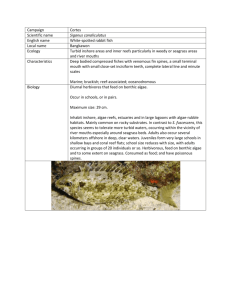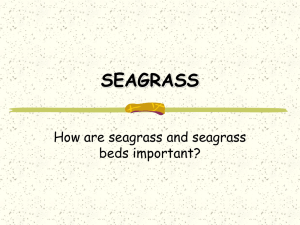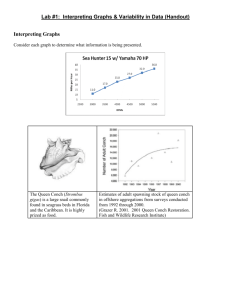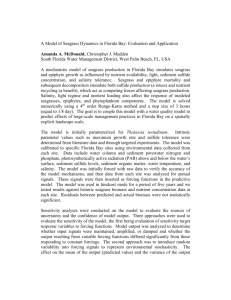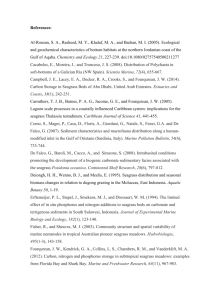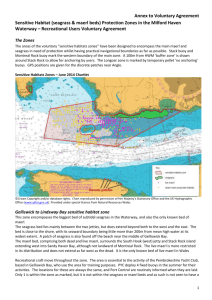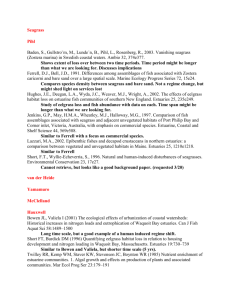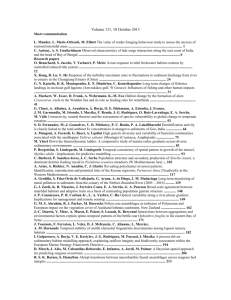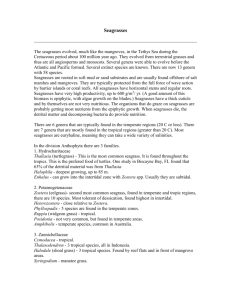Seagrass-Watch Activity Book
advertisement
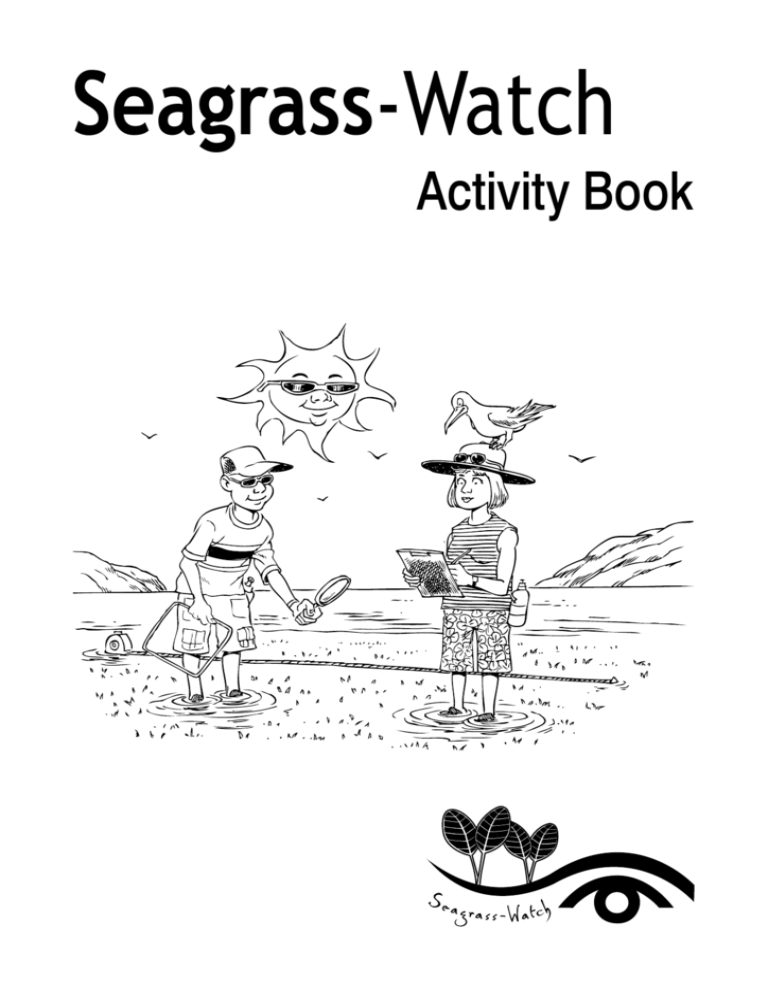
Seagrass-Watch Activity Book Sensational Seagrass Seagrass is one of the most important plants on earth. Seagrass is the only marine flowering plant. Seagrass is found in oceans throughout the world and is the basis for many important marine ecosystems. Seagrass meadows are commonly found along coastlines, on reef tops and in estuaries. Seagrass plants have roots, stems and leaves. The roots and horizontal stems (called rhizomes) are buried in the substrate and anchor the plant. Roots can be simple or branching, and have fine hairs to help absorb nutrients. Rhizomes form in segments, with leaves or vertical stems rising from the joins, which are called nodes or scars. Vertical (erect) stems are called shoots. They grow out of the sediment and have leaves. Sometimes the leaves are on a stalk, called a petiole. Seagrass have veins and air channels in their leaves and stems, so they can carry water, food and gases. Veins can be across the leaf blade or run parallel (longitudinal) to the leaf edge. At the base of a leaf is a sheath, which protects young leaves. At the other end of a leaf is the tip. Can you label the missing plant parts below from the following list? cross vein, oval leaf blade, rhizome, branching roots, stem, internode, leaf sheath, leaf tip 1: ............... leaf blade longitudinal leaf vein 2: ............... 3: ............... petiole node 4: ............... 6: ............... 5: ............... erect shoot root hair 7: ............... simple root 8: ............... 2 A special kind of grass They are called ‘seagrass’ because most have flat, ribbon-like, grassy leaves. But they are not a true grass. There are around 60 different species of seagrass world-wide, and some do not look like grass at all. Seagrass range from the size of your fingernail to plants with leaves as long as 7 metres. Leaves of different seagrass species can be shaped like a flattened ribbon, look like a fern, a clover, or even like spaghetti. No matter what the shape, seagrass leaves rely on light to convert carbon dioxide and water into oxygen and sugar (photosynthesis). The sugar and oxygen are then available for use by other living organisms, making seagrass an important link in the food web. Can you identify the three seagrass species below from the following list? HD (Halophila decipiens) HO (Halophila ovalis) • oval shaped leaves in pairs • leaf edges & blade smooth • can live on intertidal mud flats HS (Halophila spinulosa) • oblong leaves arranged like a fern • leaf edges jagged/saw-like • able to live in low light CS (Cymodocea serrulata) HU (Halodule uninervis) • strap-like leaves • leaf tip has three points • prominent single vein along middle of leaf SI (Syringodium isoetifolium) • leaves spaghetti shaped • leaf tip with single point • plants live in shallow water, not exposed at low tide • • • • oval shaped leaves fine hairs on leaf blade leaf edges jagged/saw-like able to live in low light • wide stap-like leaves • leaf tip rounded with jagged edge • plants live in shallow water, not exposed at low tide Species A: .................... Species B: .................... 3 Species C: .................... Food and shelter Seagrass is important because it is food and provides shelter for marine life. Within seagrass meadows, you can find animals such as prawns, crabs, starfish, marine slugs and seahorses. Hermit crabs are also common in seagrass meadows. Help the Hermit Crab find a new home 4 Biodiversity Seagrass meadows are very biodiverse. That means they include lots of different life forms (species). Seagrass meadows also have lots of animals living within them. About 40 times more animals occur in seagrass meadows than on bare sand. How many different animal and plant species can you count in the picture below? 5 Fisheries One of the most important roles of seagrass is providing a nursery and shelter area for fish and prawns which are valuable to recreational, commercial and indigenous fisheries. Juveniles of some important species which depend on seagrass meadows include fish such as perch, mullet, whiting, tailor, luderick, bream, flathead, snappers, emperors and sweetlips. Tiger prawns, king prawns and tropical rock lobsters also live in seagrass meadows as juveniles. Shellfish such as some oysters and pearl shell may be more likely to settle and survive where there is seagrass. What do all these animals have in common besides being valuable to fisheries?........... ......................................................................................................................................... Red throat emperor / sweetlip • • • • adults live on coral reefs and lagoon areas are bottom feeders, mainly eating crabs, sea urchins, sand dollars and fish juveniles live in shallow water seagrass meadows, moving offshore as they grow change from female to male as they grow Tiger prawn • • • • adults live and spawn offshore on muddy or sandy bottoms mainly feed at night on molluscs, crustaceans and polychaete worms young prawns settle into and live in seagrass meadows estuarine fish are major predators of juveniles prawns Red emperor • • • • are part of the family of tropical snappers and sea perches adults live on coral reefs and sand flats. juveniles live in nearshore mangrove and seagrass habitats are predators which mainly feed at night Ornate tropical rock lobster • • • • • adults live on coral or rocky reefs in spring mature adults congregate and migrate to deepwater spawning grounds adults spawn in summer in winter the postlarvae settle into seagrass meadows juveniles shelter and feed in seagrass meadows Illustrations courtesy Paul Lennon 6 Dugongs The dugong is a marine mammal which eats seagrass. Dugong can eat up to 40 kilograms of seagrass per day. When a dugong eats, it digs its snout into the sea-bed to uproot the seagrass, leaving a trail in the meadow where they have fed. Dugong can travel for great distances searching for food. They have a good memory and satellite tracking has shown that they can return hundreds of kilometres to a specific place. Two dugong have been tagged with satellite transmitters, which one will reach the seagrass meadow? 2 1 7 Sea Turtles Green sea turtles are marine reptiles that mainly feed on seagrass. They eat (crop) the leaves of the strap-like seagrass species. An adult green turtle eats about two kilograms of seagrass a day. 8 Word-Find Find the hidden words in the puzzle below. From the unused letters in the puzzle, reveal the name of the areas of the sea bottom on which marine flowering plants are present. Compass Halodule Transect Crab Halophila Turtle Dredging Intertidal Volunteer Dugong Nursery Water Quality Fishery Quadrat Zostera Habitat Subtidal W T U R T L E H T D S E A Y A G R I A A R R S H T R S S Y N S L A E A A E E H U R T S O N D R L R S A B E E A P S G E O Q R B T H R P H E I T D U U I I S T M I C N S U A N T D I I O L T G O L L B A A F D C A M E I A T L A A D U G O N G T R D V O L U N T E Y C Q U A D R A T O W S 9 Z E E R Seagrass Habitats Seagrasses need plenty of sun and clean water to grow. Seagrasses also live in locations sheltered from wave action. Species of seagrass are adapted to live in a variety of coastal marine habitats. Seagrasses are usually found growing in mud or sand, in subtidal areas (areas that are covered with salt water all the time). Subtidal areas can include very deep water (more than 15m depth). Some seagrass species can also be found in the intertidal region (covered by water during high tide and uncovered during low tide). Place the letter of each of the six seagrass species below in the correct box where you generally find that species. Hint: information on some species can be found on page 3. high tide mark saltmarsh low tide mark mangroves sand Intertidal Shallow subtidal Deep-water (>15m) a. b. Halophila spinulosa Halophila decipiens d. e. Halophila ovalis c. Cymodocea serrulata f. Zostera capricorni 10 Syringodium isoetifolium Seagrass Tidal Search To live in intertidal regions (uncovered during low tide), seagrass must put up with getting too dry, too hot and too much sunlight. When the tide goes out, little pools of water are often left behind. Sometimes, small plants and animals get left behind too. Occasionally animals like dugongs can be stranded when the tide drops quickly. How many dugongs can you find hidden in this picture? 11 Seagrass Food Webs In a seagrass meadow as elsewhere, all the living things are connected to each other. Lets look at an example. In a reef lagoon green turtles eat seagrass, and sharks eat the green turtles. This is called a food chain. eaten by seagrass eaten by green turtle shark Energy Energy in a food chain moves from the plant to the first animal, and on to the second animal. At each stage energy is used by many things. Seagrass uses some of it’s energy to flower and make seeds. The dugong uses energy to breed and move about. leaf fragments drift & export herbivorous fish green turtle sinking & decay epiphytes dissolved organic matter sponges zooplankton dugong phytoplankton juvenile fish & prawns sea urchin detritus sea cucumber crab worms roots binding sediments Food chains tell us about one feeding relationship. In a place like a seagrsss meadow there are many different feeding relationships which are connected together to form a food web. Food webs are not fixed because feeding relationships can change. In the food web above many of the plants and animals depend on each other. 12 Seagrass Food Webs Can you construct a food web? Use the structure below and write the name of each plant or animal group in it’s correct location in the food web. Facts to help you: Tick off the groups when • arrows show the movement of energy you have used them: • food chains start with a plant • giant perch are large predators that are found in tidal waters where they feed on prawns and surface fish such as garfish • dugong are marine mammals that graze on seagrass • garfish eat plants • molluscs and worms eat seagrass detritus • whiting are a fish that forage for burrowing benthic animals such as worms • sea birds such as pelicans prey on whiting • sharks prey on large fish, such as sea perch, and marine mammals • crocodiles prey on large fish, such as giant perch, and marine mammals • prawns feed primarily at night, on benthic animals such as molluscs and polychaete worms • crabs are scavengers, eating worms and prawns • detritus includes the organic material from decomposing plants • sea perch consume mainly crabs, followed by prawns and benthic fish dugong start here crab pelican crocodile prawns detritus sea perch dugong seagrass garfish shark giant perch whiting molluscs worms crocodile garfish seagrass molluscs detritus giant perch prawns worms crab shark sea perch pelican whiting 13 Damaging seagrass Seagrass meadows are fragile ecosystems. Worldwide there is concern that seagrass meadows are being lost due to the activities of people. People can damage or destroy seagrass by pollution (sewage, oil spills and coastal runoff) and physical destruction (dredging, boat propellers and anchors/moorings). Physical damage can cause scars within a seagrass meadow. Damage can be both natural or by people. Below is a birds eye view of an intertidal seagrass meadow. Can you identify what caused the damage (scars) to the meadow? How many scars have been caused by: • dugongs feeding .......... • shorebirds feeding .......... • boat propellers .......... • boat anchors .......... • boats swinging on moorings .......... • digging for bait worms .......... Help stop the damage There are many ways you can help stop damage to seagrass meadows: don’t litter; be aware when applying fertilizers and pesticides, as excess amounts can wash down gutters and drains to the sea; when boating, slow down and avoid shallow areas; support marine conservation program; learn about these special marine habitats and volunteer to monitor their health by joining Seagrass-Watch. 14 Seagrass Monitoring: Spot the difference We can see if seagrass meadows are healthy by watching them over time – this is called monitoring. Seagrass-Watch is a seagrass monitoring program which measures seagrass health and makes us aware of any damage or loss. How observant are you? Can you spot the ten things different between the two pictures below? 15 Seagrass Monitoring One way we can monitor seagrass is to measure the amount or cover of seagrass within a square frame (quadrat) and compare this over time. In each of the quadrats below, measure the percentage of each seagrass species (Halophila and Zostera) and add them together to make up the total cover. Each grid is equal to 1%. Legend Halophila Q1. % Halophila = Zostera Q2. % Halophila = % Zostera = TOTAL COVER = % Zostera = TOTAL COVER = Q3. % Halophila = Q4. % Halophila = % Zostera = TOTAL COVER = % Zostera = TOTAL COVER = 16 Seagrass Mapping Seagrasses can form extensive meadows, similar to grasslands. These meadows occur along our coastlines, particularly in sheltered, shallow waters of estuaries, bays and lagoons, as well as on reef tops and on the sheltered sides of many off- shore islands. One way to monitor seagrass meadows is to map them over time. From the three maps below, calculate the area of each seagrass meadow for each year and plot the results in a stacked bar graph below. Each grid equals 1 hectare. Why do you think meadows would change between years? ................................................................. 1998 1999 Muddy River Legend 2000 Halophila meadow Zostera meadow mudbank land area of seagrass (hectares) 50 40 30 20 10 1998 17 1999 2000 Word Scramble 1. ANDS ____ 2. PHAILOHAL _________ 3. ITMORNO _______ 4. MSACOCP _______ 5. EMALPS ______ 6. TEUVELONR _________ 7. CBRA ____ 8. HLULODAE ________ 9. ZRTAEOS _______ 10. DOOF ____ 11. DRSGNIMIOYU ___________ 12. DTAARQU _______ 13. TADAEHTSE _________ 14. TECNASRT ________ 15. TULRET ______ 16. IBTATAH _______ 17. AOESSHER ________ 18. HPATES _________ 19. OGGUND ______ 20. MYEOOCCAD _________ 21. SGRASSAE ________ 22. RANPW _____ 18 Crossword 1 Across 1. Sampling intertidal seagrass meadows is best done at low _ _ _ _ Down 1. Quadrats are placed along a 50m _ _ _ _ _ _ _ _ 2. This marine mammal eats seagrass 3. This marine reptile eats seagrass 5. Seagrass fruits contain _ _ _ _ _ 4. 8. A set of information used to identify seagrass (or a device to lock a door) Seagrass meadows act as _ _ _ _ _ _ _ areas for baby prawns and fish 6. The hollow tube used to collect seagrass seeds is a _ _ _ _ _ During a cyclone, be prepared for a tidal _ _ _ _ _ 7. Seagrass species with many cross veins and rounded leaf tip (ZC) 9. 11. Global Positioning System (initials) 12. A transect is set up using a 50m _ _ _ _ measure 10. Fish eggs 14. Device that holds a boat in place at sea 15. A group of whales 19. A square frame that the seagrass percent covers are estimated within 16. A marine flowering plant 13. Seagrass with 3 pointed leaf tip 17. Used for sifting sediment to find seeds 20. You use them to measure canopy height 18. A crustacean that uses seagrass meadows as a nursery area 21. Image taken as a permanent record of percent covers within a quadrat. 19 Crossword 2 Down 1. Species of Halophila which has a lateral shoot bearing 10-20 pairs of opposite leaflets (fern-like) 2. Seagrass structures used to anchor the plant and absorb nutrients 3. Growing tip of a seagrass 4. Stalk of Halophila ovalis leaves 6. Open expanses of intertidal mud 7. Species of Cymodocea with rounded leaf tip 8. Soil/matter that settles to the bottom of a water body 9. Single leaf structure arising immediately from the horizontal rhizome unique to the genus Zostera 11. A fixed unit, usually square, used for sampling 14. A cylindrical sample of benthos and substratum obtained by the use of a hollow tube 15. Satellite-based navigation system Across 1. Species of Cymodocea with a distinctly jagged leaf tip 5. number of points on the leaf tip of Halodule uninervis 6. Repeated observation of a site to detect change 10. Genus of seagrass whos leaves are round in cross-section (spaghetti like) 12. A paper form used to record field data in a set format 13. Self-Contained Underwater Breathing Apparatus 16. Beneath the low watermark 17. Structure which encloses the growing end of a stem and protects young leaves Hint: you can find information on seagrass identification by visiting www.seagrasswatch.org 20 Local Eyes: Global Wise Seagrass-Watch is a global scientific seagrass assessment and monitoring program. Which of the following Seagrass-Watch regions or countries is missing? H T J D V O V A L A U V E L I T I V B K Z C P D N A L S I N O T G N I N R O M B K B A N G L A D E S H R N A E R T I R E O T P E Y S I N G A P O R E K O M O D O S J U Q B I Y A B R E T A W L A O H S D R M A D A N G L S P S U S J D M E A A A A T N E P D O S U Y Y M Z A E N W I B N E M E H A O J I D A A A N P O A X S A A N A W N L N P N S I P D B A J C E Y H M O C G E A E A O D S H E N N A Q D A C B Philippines Pohnpei Rotuma Sabah Shoalwater Bay Singapore Solomon Islands Thailand Torres Strait Townsville Viet Nam Viti Levu Whitsundays Madang Malaysia Manado Micronesia Mission Beach Moreton bay Mornington Island Napranum New Caledonia Noosa Ovalau Palau Papua New Guinea Gladstone Gold Coast Great Sandy Strait Hervey Bay India Indonesia Japan Karimunjawa Kavieng Komodo Kosrae Lau Mackay Australia Bali Bangladesh Bowen Broome Cairns China Cooktown Eritrea Fiji Fitzroy Flores Gizo T K U W U S I M N E I V U U O R G L O S 21 S A I C T I L O A N L M I H S T N A O J D Y N A B A A L L O I L J E S T E M K G A O E L G A R O I R P J I R T T I R T L L R A E I B T S A C P X F V E N V H O A G Z W D Z A S K H I I D N E S M A Z W M O T N O O L U B T M N D O Y Y N K M N X V I S N R I A C D N E W O B F J W Z D T G F I I E P N H O P S U S A S E R O L F M U N A R P A N I H C Y A Y F S K Q T L Solutions Sensational Seagrass: 1=leaf tip; 2=oval leaf blade; 3=cross vein; 4=leaf sheath; 5=stem; 6=internode; 7=rhizome; 8=branching roots Mapping continued..: The change in meadows between years may be due to: runoff (poor water quality) from Muddy River. Increased turbidity could cause the loss of Halophila meadow and some of intertidal Zostera meadow (in 1999). Increased nutrients could aid expansion of intertidal Zostera in 2000. A special kind of grass: species A = HS, species B = HU, species C = HO Word scramble: 1. sand, 2. Halophila, 3. monitor, 4. compass, 5. sample, 6. volunteer, 7. crab, 8. Halodule, 9. Zostera, 10. food, 11. Syringodium, 12. quadrat, 13. datasheet, 14. transect, 15. turtle, 16. habitat, 17. seahorse, 18. gastropod, 19. dugong, 20. Cymodocea, 21. seagrass, 22. prawn Biodiversity: 15 (4 fish, 3 seagrass, 1 crab, 1 scallop, 2 snails, 1 prawn, 1 marine mammal, 1 starfish, 1 sand dollar) Fisheries: adults live offshore, juveniles live in nearshore seagrass meadows Crossword 1: Dugong maze: tagged dugong number 2 Word find: seagrass meadows Habitats: intertidal = d & e; shallow subtidal = c & f; deep-water =a&b Tide Pool Search: 18 Food web: dugong crocodile garfish seagrass molluscs detritus giant perch prawns worms crab Crossword 2: shark sea perch pelican whiting Damaging scars: 6 dugongs feeding trails (wavy lines); 2 bird feeding areas (groups of dots); 8 boat propellers (straight lines or arcs); 3 boat anchors (squares); 1 boat swinging on its mooring (semi-circle); 1 bait worm digging area (dashed rectangle). Local Eyes: Global Wise: missing region is Torres Strait Spot the difference: Flying bird missing, ruler shorter, mans tongue not poking out, less wrinkles on back of mans shirt, no hair on mans legs, no flash on camera, pocket missing from ladies shorts, pocket missing from backpack, ripple missing from around ladies legs, island in background smaller for more information, visit www.seagrasswatch.org Monitoring: Q1, Halophila=8, Zostera=45, TOTAL=53 Q2, Halophila=0.5, Zostera=30, TOTAL=30.5 Q3, Halophila=25, Zostera=36, TOTAL=61 Q4, Halophila=40, Zostera=12, TOTAL=52 Mapping: area of seagrass (hectares) 50 40 20 Booklet by Len McKenzie, Rudi Yoshida & Jane Mellors. Produced by Seagrass-Watch HQ Supported by the Australian Government’s Marine and Tropical Sciences Research Facility (Department of the Environment, Water, Heritage and the Arts) represented in North Queensland by the Reef and Rainforest Research Centre and the Queensland Department of Primary Industries & Fisheries. 30 30 5 20 40 1998 1999 2000 20 10 22 Seagrass-Watch HQ, PO Box 5396 Cairns QLD 4870 AUSTRALIA Phone: +61 7 4057 3731 Fax: +61 7 4057 3810 Email: hq@seagrasswatch.org Web: www.seagrasswatch.org This bookmark is the property of ........................................................................................................ Seagrass-Watch HQ, PO Box 5396 Cairns QLD 4870 AUSTRALIA Phone: +61 7 4057 3731 Fax: +61 7 4057 3810 Email: hq@seagrasswatch.org Web: www.seagrasswatch.org This bookmark is the property of ........................................................................................................ Seagrass-Watch HQ, PO Box 5396 Cairns QLD 4870 AUSTRALIA Phone: +61 7 4057 3731 Fax: +61 7 4057 3810 Email: hq@seagrasswatch.org Web: www.seagrasswatch.org This bookmark is the property of ........................................................................................................ Seagrass-Watch HQ, PO Box 5396 Cairns QLD 4870 AUSTRALIA Phone: +61 7 4057 3731 Fax: +61 7 4057 3810 Email: hq@seagrasswatch.org Web: www.seagrasswatch.org This bookmark is the property of ........................................................................................................ Seagrass-Watch HQ, PO Box 5396 Cairns QLD 4870 AUSTRALIA Phone: +61 7 4057 3731 Fax: +61 7 4057 3810 Email: hq@seagrasswatch.org Web: www.seagrasswatch.org This bookmark is the property of ........................................................................................................ Make your own bookmark. Colour the images and cut out along dotted line.
